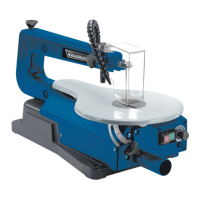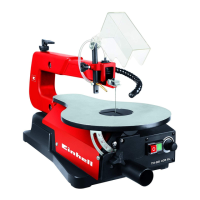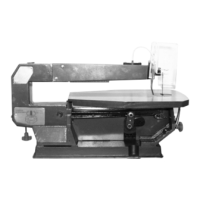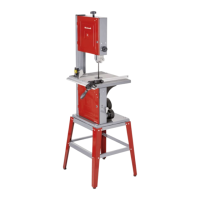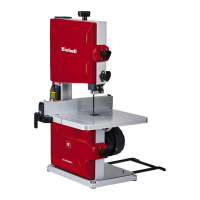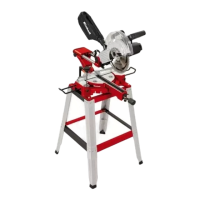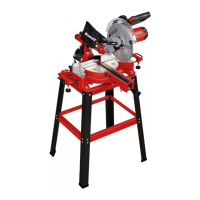For cutting to occur, you have to guide the wood against the blade.
The teeth cut only on the down stroke of the blade.
You have to guide the wood slowly against the blade because the teeth are very small.
Every new user needs a certain training period. You are certain to break a number of blades at the beginning.
When cutting thick timber, be particularly careful not to bend or twist the blade. This will help to prolong blade
life.
On/Off switch (Fig. 3)
Press the green button to switch the saw on.
Press the red button to switch the machine off.
Please note: The machine is equipped with a safety switch to prevent it being switched on again accidentally
after a power failure.
Blade speed regulator (Fig. 3)
The blade speed regulator allows you to set the blade speed appropriate to the material to be cut.
Carrying out internal cuts
1. A feature of this fretsaw is that it allows you to carry out internal cuts in a panel without damaging it on the
outside or circumference.
Warning: To avoid injury from accidental starting:
Before you remove or change the blade, always set the switch to „0“ position and pull the power plug out of the
socket.
2. To carry out internal cuts in a panel: Remove the blade as described in Section 5.2.2
3. Drill a hole in the panel in question.
4. Place the panel on the saw table with the drilled hole above the access hole.
5. Install the blade through the hole in the panel and adjust the blade tension.
6. When you have completed the internal cuts, remove the blade from the blade holders (as described in Section
5.2.2) and take the panel off the table.
Replacing the power cable
Dange:
If the power cable for this equipment is damaged, it must be replaced by the manufacturer or its after-sales service or
similarly trained personnel to avoid danger.
Cleaning, maintenance and ordering of spare parts
Danger:
Always pull out the mains power plug before starting any cleaning work.
Cleaning
Keep all safety devices, air vents and the motor housing free of dirt and dust as far as possible. Wipe the
equipment with a clean cloth or blow it with compressed air at low pressure.
We recommend that you clean the device immediately each time you have finished using it.
Clean the equipment regularly with a moist cloth and some soft soap. Do not use cleaning agents or solvents;
these could attack the plastic parts of the equipment. Ensure that no water can seep into the device.
Carbon brushes
In case of excessive sparking, have the carbon brushes checked only by a qualified electrician.
Important! The carbon brushes should not be replaced by anyone but a qualified electrician.
Maintenance
There are no parts inside the equipment which require additional maintenance.

